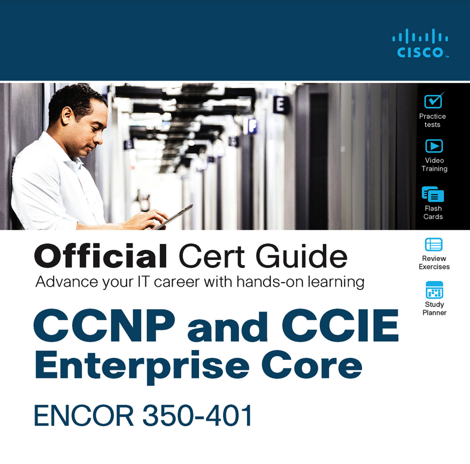Cisco CCNP Tutorials Training Course
Mastering CCNP: Comprehensive Guide and Tutorials
- Experienced instructors with industry expertise
- Access to official guides and materials
- Covers all exam topics thoroughly
- Flexible study at your own pace
- Support for exam service
- Anytime access to study resources
What you'll learn
Training Course Outline
Cisco CCNP Tutorials
1. Introduction to CCNP
2. What is Link Aggregation?
3. What is IPv6 Routing?
4. Static Routes and Administrative Distance
5. What is Layer 2 Security?
6. Enhanced Interior Gateway Routing Protocol
7. What is Exterior Border Gateway Protocol?
8. What is Network Monitoring?
9. Introduction to OSPF
10.What is Layer 3 Path Control?
11. Virtual Local Area Networks (VLAN) and Trunks
12. Virtual Router Redundancy Protocol | What is GLBP?
13. What is Advanced Spanning Tree?
14. What is Redistribution?
15. Troubleshooting IPv4
16. Troubleshooting Router/Switch Performance
17. Virtual Local Area Network Trunking Protocol
18. Switch Port Configuration
19. Switch Architecture and Operation
20. Troubleshooting Methods
21. Troubleshooting Spanning Tree and VLAN
22. IPv6 to/from IPv4
23. What is Branch Office Implementation?
24. Introduction InterVLAN Routing
25. Troubleshooting AAA for Authentication and VLANs
26. What is Traditional Spanning Tree?
27. Network Maintenance
28. Consideration For Wireless, VoIP, and Video
29. Troubleshooting NAT
30.What is Hot Stand By Router Protocol?
31. What is Troubleshooting Security?
32. Troubleshooting Voice and Video
33. Trouble Shooting Internet Protocol Version 6
34. Troubleshooting High Availability First Hop Redundancy Protocol
35. IOS Device Maintenance
Training Options
Self Paced Learning
- Lifelong access to high-quality content
- Curated by industry experts
- Customized learning progress
- 24/7 learner assistance and support
- Follow the latest technology trends
Exam Dump
- 100% Real Exam Practice Tests
- 100% Verified Exam Questions & Answers
- 100% Guarantee Passing Rate
- Average 7 Days to Practice & Pass
Description
Cisco Certified Network Professional (CCNP?) certification is comprised of three separate areas: Routing, Switching and Troubleshooting and CCNP? certification establishes one's proficiency across these three areas.
Pre-requisites
The course has no specific prerequisites.

Official Cert Guide CCNP and CCIE Enterprise 350-401
Advance your career with hands-on learning
Cisco CCNP Certification Preparation FAQs
What Is the Best Way to Learn CCNP?
The most effective way to prepare for the Cisco CCNP certification is to utilize official Cisco study resources, gain hands-on experience in a lab environment, participate in study groups, and regularly take practice exams. Depending on prior networking knowledge and study dedication, candidates typically require between 9 to 18 months to complete all three CCNP exams with strong results.
How Long Does It Take to Prepare for CCNP?
On average, it takes about 3 to 6 months to prepare for the CCNP exam, though this timeline can vary based on individual experience, learning speed, and study commitment. Candidates who dedicate 10-15 hours per week to focused studying can generally complete their preparation within this timeframe.
Can You Skip CCNA and Go Straight to CCNP?
While it is possible to pursue the CCNP certification without holding a CCNA, having a solid understanding of CCNA-level networking concepts is crucial. It is strongly recommended to first build a foundation with CCNA knowledge before attempting CCNP exams to ensure a smoother learning experience.
Does CCNP Certification Help in Job Opportunities?
Earning a CCNP certification significantly enhances career prospects by qualifying candidates for advanced networking roles. With a CCNP, professionals can pursue positions such as Network Engineer, Systems Engineer, or IT Manager, where they take on more complex networking tasks, lead projects, and even manage teams.
Which CCNP Track Is the Best?
CCNP Enterprise remains the most valuable certification path for networking professionals looking to expand their expertise in modern network environments. However, those working in specialized areas, such as data centers, may find CCNP Data Center a better fit for their career growth. Choosing the right CCNP track depends on your professional goals and industry focus.